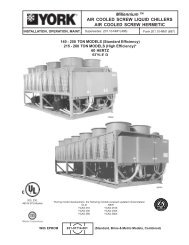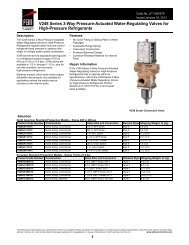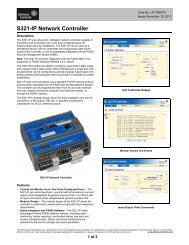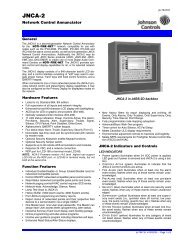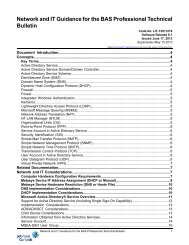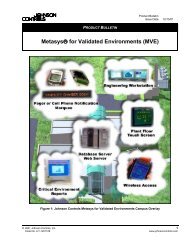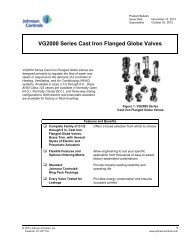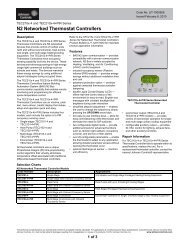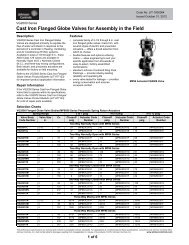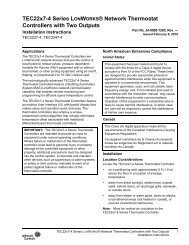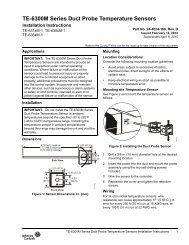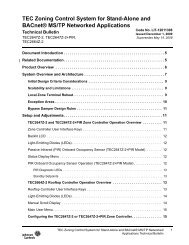Weekly Testing of Dedicated Smoke Control Dampers - Metasys ...
Weekly Testing of Dedicated Smoke Control Dampers - Metasys ...
Weekly Testing of Dedicated Smoke Control Dampers - Metasys ...
Create successful ePaper yourself
Turn your PDF publications into a flip-book with our unique Google optimized e-Paper software.
<strong>Weekly</strong> <strong>Testing</strong> <strong>of</strong> <strong>Dedicated</strong> <strong>Smoke</strong> <strong>Control</strong> <strong>Dampers</strong> -<strong>Metasys</strong>® System Extended ArchitectureApplication NoteCode No. LIT-1201743Release 1.2Issued Date July 30, 2004SupersedesDocument Introduction . . . . . . . . . . . . . . . . . . . . . . . . . . . . . . . . . . . . . . . . . . . . . . . . . 3Related Documentation. . . . . . . . . . . . . . . . . . . . . . . . . . . . . . . . . . . . . . . . . . . . . . . . . 3Application Overview . . . . . . . . . . . . . . . . . . . . . . . . . . . . . . . . . . . . . . . . . . . . . . . . . . 4<strong>Smoke</strong> <strong>Control</strong> Command Priorities . . . . . . . . . . . . . . . . . . . . . . . . . . . . . . . . . . . . . . . . . 4Automatic <strong>Smoke</strong> <strong>Control</strong> During <strong>Weekly</strong> <strong>Testing</strong> . . . . . . . . . . . . . . . . . . . . . . . . . . . . . . 5Manual <strong>Smoke</strong> <strong>Control</strong> During <strong>Testing</strong> . . . . . . . . . . . . . . . . . . . . . . . . . . . . . . . . . . . . . . . 5Assigning the Fire Object Category to <strong>Smoke</strong> <strong>Control</strong> Objects . . . . . . . . . . . . . . . . . . . 5Security Administration System. . . . . . . . . . . . . . . . . . . . . . . . . . . . . . . . . . . . . . . . . . . . . 6Roles and User Accounts Overview . . . . . . . . . . . . . . . . . . . . . . . . . . . . . . . . . . . . . . . . . . . 6UUKL <strong>Smoke</strong> <strong>Control</strong> Security Administration Details. . . . . . . . . . . . . . . . . . . . . . . . . . . . . . 6Security Administration Detailed Procedures. . . . . . . . . . . . . . . . . . . . . . . . . . . . . . . . . . . . . 8Creating a New Role . . . . . . . . . . . . . . . . . . . . . . . . . . . . . . . . . . . . . . . . . . . . . . . . . . . . . . . . . . . 8Creating a New User Account . . . . . . . . . . . . . . . . . . . . . . . . . . . . . . . . . . . . . . . . . . . . . . . . . . . . 8Configuring User Pr<strong>of</strong>iles . . . . . . . . . . . . . . . . . . . . . . . . . . . . . . . . . . . . . . . . . . . . . . . . . . . . . . . . 8Configuring Role Properties . . . . . . . . . . . . . . . . . . . . . . . . . . . . . . . . . . . . . . . . . . . . . . . . . . . . . 9Assigning System Access Permissions . . . . . . . . . . . . . . . . . . . . . . . . . . . . . . . . . . . . . . . . . . . . . 9Design Considerations . . . . . . . . . . . . . . . . . . . . . . . . . . . . . . . . . . . . . . . . . . . . . . . . . 9<strong>Smoke</strong> <strong>Control</strong> NAE Design Considerations. . . . . . . . . . . . . . . . . . . . . . . . . . . . . . . . . . . 9Field <strong>Control</strong>ler Point Design Considerations . . . . . . . . . . . . . . . . . . . . . . . . . . . . . . . . 10Field <strong>Control</strong>ler Points . . . . . . . . . . . . . . . . . . . . . . . . . . . . . . . . . . . . . . . . . . . . . . . . 12Field <strong>Control</strong>ler Selection . . . . . . . . . . . . . . . . . . . . . . . . . . . . . . . . . . . . . . . . . . . . . . . . . 12Point List. . . . . . . . . . . . . . . . . . . . . . . . . . . . . . . . . . . . . . . . . . . . . . . . . . . . . . . . . . . . . . . 12<strong>Smoke</strong> <strong>Control</strong> NAE Application . . . . . . . . . . . . . . . . . . . . . . . . . . . . . . . . . . . . . . . . 13Application File Location . . . . . . . . . . . . . . . . . . . . . . . . . . . . . . . . . . . . . . . . . . . . . . . . . 13<strong>Metasys</strong> System Extended Architecture Objects . . . . . . . . . . . . . . . . . . . . . . . . . . . . . . 13Damper 6-1 . . . . . . . . . . . . . . . . . . . . . . . . . . . . . . . . . . . . . . . . . . . . . . . . . . . . . . . . . . . . 14<strong>Weekly</strong> <strong>Dedicated</strong> Damper Test . . . . . . . . . . . . . . . . . . . . . . . . . . . . . . . . . . . . . . . . . . . . 19<strong>Weekly</strong> <strong>Testing</strong> <strong>of</strong> <strong>Dedicated</strong> <strong>Smoke</strong> <strong>Control</strong> <strong>Dampers</strong> - <strong>Metasys</strong>® SystemExtended Architecture Application Note1
<strong>Weekly</strong> <strong>Testing</strong> <strong>of</strong> <strong>Dedicated</strong> <strong>Smoke</strong> <strong>Control</strong><strong>Dampers</strong> - <strong>Metasys</strong>® System ExtendedArchitectureApplication NoteDocument Introduction<strong>Smoke</strong> control applications issue commands to controlled devices that pressurizeor depressurize an area <strong>of</strong> a building to minimize the spread <strong>of</strong> smoke. Thisdocument describes weekly testing <strong>of</strong> a dedicated smoke control damper in the<strong>Metasys</strong> system extended architecture.This application is designed to provide aweekly test <strong>of</strong> a dedicated smoke control damper automatically.Note: This application note only presents an example <strong>of</strong> one smoke controlstrategy. Since every building is unique, details <strong>of</strong> applying the strategyvary. This application note can assist you to develop an appropriateapplication for your project.Related DocumentationTable 1: Related DocumentationFor Information On Refer To LIT No./Part No.General smoke control informationSpecific wiring requirementsLogic programming for the DX-9100controllerSingle story enclosed shopping mallsmoke controlMulti-story building smoke controlWarehouse smoke control<strong>Weekly</strong> testing <strong>of</strong> stairwellpressurization fansUL® 864 UUKL Requirements<strong>Metasys</strong> System Extended Architecture<strong>Smoke</strong> <strong>Control</strong> System Technical Bulletin<strong>Metasys</strong> System Extended Architecture<strong>Smoke</strong> <strong>Control</strong> Wiring Technical BulletinGX-9100 S<strong>of</strong>tware Configuration ToolTechnical BulletinSingle Story Enclosed Shopping Mall<strong>Smoke</strong> <strong>Control</strong> with FSCS Override -<strong>Metasys</strong> System Extended ArchitectureApplication NoteMulti-Story Building <strong>Smoke</strong> <strong>Control</strong> withFSCS Override - <strong>Metasys</strong> SystemExtended Architecture Application NoteWarehouse <strong>Smoke</strong> <strong>Control</strong> with FSCSOverride - <strong>Metasys</strong> System ExtendedArchitecture Application Note<strong>Weekly</strong> <strong>Testing</strong> <strong>of</strong> <strong>Dedicated</strong> StairwellPressurization Fans – <strong>Metasys</strong> SystemExtended Architecture Application NoteMSEA <strong>Smoke</strong> <strong>Control</strong> UL 864 UUKLCompliance ChecklistLIT-1201684LIT-1201753LIT-6364060LIT-1201736LIT-1201737LIT-1201738LIT-1201739LIT-1201754<strong>Weekly</strong> <strong>Testing</strong> <strong>of</strong> <strong>Dedicated</strong> <strong>Smoke</strong> <strong>Control</strong> <strong>Dampers</strong> - <strong>Metasys</strong>® System Extended ArchitectureApplication Note3
Application OverviewThis application is designed to perform a weekly test <strong>of</strong> a dedicated smoke controldamper automatically. A schedule on the smoke control NAE commands theweekly dedicated damper test. A Trouble alarm is issued if the status feedbackindicator from the damper does not equal the damper command sent by the NAE.Note: <strong>Weekly</strong> dedicated damper test commands are issued at a Priority 7.A schedule on the Network Automation Engine (NAE) triggers the test, and thedamper is commanded Open for 2 minutes. If the damper does not open on within75 seconds <strong>of</strong> the controller’s Open command, the damper’s Trouble Light-Emitting Diode (LED) on the Firefighter’s <strong>Smoke</strong> <strong>Control</strong> Station (FSCS) isturned on. After the first 2 minutes has expired the damper is then commanded toClose. If the damper does not close within 75 seconds <strong>of</strong> the controller’s closecommand, the damper’s Trouble LED on the FSCS is turned on. After the2 minutes has expired, the test is disabled, the damper is restored to its normalstate, and the Retry logic will retry the test every 60 minutes until the test passes.Once the weekly test passes, the logic will disable the weekly test until its nextscheduled test time.The application contains logic that issues a Priority 7 command to Open thededicated damper for 2 minutes. After 2 minutes has passed, the logic then issues aPriority 7 command to Close the dedicated damper. After 2 minutes has passed, thePriority 7 command is released.If the damper does not reach the desired feedback within 75 seconds, a DamperFailure BACnet Binary Value object (BV) is latched to true. The Auto CommandRetry logic will retry the test every 60 minutes until the test passes. Once theweekly test passes, the logic will disable the weekly test until its next scheduledtest time.The Alarm Logic process is triggered if any <strong>of</strong> the following occurs:• a dedicated damper goes into alarm during the pressurization test. An alarmsituation would occur if the fan feedback did not equal the fan command.• the operator tests the alarm process manually.If the damper is in alarm and it is in the testing schedule and the Reset is false, theSonalert® is energized.<strong>Smoke</strong> <strong>Control</strong> Command PrioritiesAll automatic smoke control commands are issued at Priority 3. Fire fightermanual overrides, issued from the FSCS panel to pressurize or depressurize zones,are commanded at Priority 2. Fire fighter manual overrides, issued from the FSCSpanel to control individual fans and dampers, are commanded at Priority 1.Priority 3 commands are released when the smoke alarm is reset. <strong>Weekly</strong> testcommands are issued at Priority 7.4<strong>Weekly</strong> <strong>Testing</strong> <strong>of</strong> <strong>Dedicated</strong> <strong>Smoke</strong> <strong>Control</strong> <strong>Dampers</strong> - <strong>Metasys</strong>® System Extended ArchitectureApplication Note
Automatic <strong>Smoke</strong> <strong>Control</strong> During <strong>Weekly</strong> <strong>Testing</strong>Automatic smoke control operations that take place during a weekly dedicateddamper test always override the weekly dedicated damper test.Manual <strong>Smoke</strong> <strong>Control</strong> During <strong>Testing</strong>Manual <strong>Smoke</strong> <strong>Control</strong> logic is initiated when a fire fighter turns the FSCS PanelEnable key from the Auto position to Fire Fighter <strong>Control</strong> position and changes apoint from the Auto setting on the FSCS panel. Manual smoke control operationsduring a weekly dedicated damper test always override the weekly dedicateddamper test.Assigning the Fire Object Category to <strong>Smoke</strong> <strong>Control</strong> ObjectsYou must assign every object used specifically for smoke control as a Fire object.This limits the control <strong>of</strong> smoke control devices and points to authorized Fireoperators.Use the pull down menu to assign the Fire object category (Figure 1).Figure 1: Assigning the Fire Object to <strong>Smoke</strong> <strong>Control</strong> Objects!WARNING: Risk <strong>of</strong> serious injury or death if a smoke controlobject is not assigned as a Fire object! In the event <strong>of</strong> a fire orsmoke control event, devices or points used for smoke controlthat are not assigned as Fire objects allow those devices andpoints to be controlled by non-fire authorized operators. It isimperative that every smoke control device or point be assignedas a Fire object.<strong>Weekly</strong> <strong>Testing</strong> <strong>of</strong> <strong>Dedicated</strong> <strong>Smoke</strong> <strong>Control</strong> <strong>Dampers</strong> - <strong>Metasys</strong>® System Extended ArchitectureApplication Note5
Security Administration SystemThe Security Administration system authenticates and authorizes users <strong>of</strong><strong>Metasys</strong>® system extended architecture applications. The Security Administratoris a browser-based interface that manages all accounts.Use the Security Administrator System to authenticate and authorize users on the<strong>Metasys</strong> system extended architecture. The Security Administrator creates UserAccounts and Roles, and assigns access permissions to each user <strong>of</strong> the <strong>Metasys</strong>system extended architecture.Roles and User Accounts OverviewSecurity is based on User Accounts and Roles. Roles are groups <strong>of</strong> users with aspecific function within the <strong>Metasys</strong> system. To access the system, an individualprovides a user account and the correct password. Use letters, numbers, or symbolsto create user account passwords.Use the Login button from the logon prompt to send the user’s credentials. Aunique Session generates when the user’s credentials match the logonrequirements.UUKL <strong>Smoke</strong> <strong>Control</strong> Security Administration DetailsUUKL smoke control requires that only operators designated as fire operators beable to control the smoke control system. This required the creation <strong>of</strong> four newroles:1. Administrator - This is the highest level <strong>of</strong> control and allows site control <strong>of</strong> allHVAC and Fire features.Fire Administrator - This role is a fire manager levelsetting. It allows for full system control, including system modification orconfiguration.6<strong>Weekly</strong> <strong>Testing</strong> <strong>of</strong> <strong>Dedicated</strong> <strong>Smoke</strong> <strong>Control</strong> <strong>Dampers</strong> - <strong>Metasys</strong>® System Extended ArchitectureApplication Note
2. Fire Administrator - This role is a fire manager level setting. It allows for fullsystem control, including system modification or configuration.Figure 2: Fire Administrator Access Permissions3. Fire User - This role is for most fire field technicians and allows system controland alarm acknowledgement, but not system modification or configuration.Figure 3: Fire User Access Permissions<strong>Weekly</strong> <strong>Testing</strong> <strong>of</strong> <strong>Dedicated</strong> <strong>Smoke</strong> <strong>Control</strong> <strong>Dampers</strong> - <strong>Metasys</strong>® System Extended ArchitectureApplication Note7
4. Fire Limited - This is the lowest <strong>of</strong> the permissions and only allows theoperator to view fire/smoke control devices and alarms.Security Administration Detailed ProceduresCreating a New RoleTo create a new role:1. From the Security Administration menu bar, select Insert > New Role. TheNew Role dialog box appears.2. Fill in the information.3. Click OK. The New Role appears in the tree.Creating a New User AccountTo create a new user account:1. From the Security Administration menu bar, select Insert > New User. TheUser Properties tab appears.2. Fill in the information.3. Click OK. The New User appears in the tree.Configuring User Pr<strong>of</strong>ilesTo configure a user pr<strong>of</strong>ile:1. Select the user whom you wish to configure.2. From the menu bar, select Edit > Properties. The User Properties tab appears.3. Modify the desired user information.4. Click OK.Figure 4: Fire Limited Access Permissions8<strong>Weekly</strong> <strong>Testing</strong> <strong>of</strong> <strong>Dedicated</strong> <strong>Smoke</strong> <strong>Control</strong> <strong>Dampers</strong> - <strong>Metasys</strong>® System Extended ArchitectureApplication Note
Configuring Role PropertiesTo configure role properties:1. Select the user whom you wish to configure.2. From the menu bar, select Edit > Properties. The User Properties tab appears.3. Select the Roles tab, then select an Available Role.4. Click Add. The selected role appears in the Assigned Role list box.5. Click OK.Assigning System Access PermissionsTo assign system access permissions:1. Select the user whom you wish to assign system access permissions.2. From the main menu, select Edit > System Access Permissions. The SystemAccess Permission dialog box appears.3. Select an available privilege.4. Click Add, then click OK to assign the user’s System Access Permissions.Design ConsiderationsThis field controller and <strong>Smoke</strong> <strong>Control</strong> NAE application, as it exists in the<strong>Metasys</strong> System Extended Architecture <strong>Smoke</strong> <strong>Control</strong> Library, complies with theUL 864 UUKL <strong>Smoke</strong> Listing. However, you are responsible for ensuring that theapplication complies with state and local regulations, and is approved by theAuthority Having Jurisdiction (AHJ). You are also responsible for configuring all<strong>of</strong> the smoke control components, as well as the programming <strong>of</strong> thosecomponents, in order to comply with the UL 864 UUKL <strong>Smoke</strong> Listing asdocumented herein.<strong>Smoke</strong> <strong>Control</strong> NAE Design ConsiderationsKeep the following design considerations in mind when designing a weeklydedicated smoke control damper test. In addition, please refer to the <strong>Metasys</strong>System Extended Architecture <strong>Smoke</strong> <strong>Control</strong> System Technical Bulletin(LIT-1201684).• The smoke control NAE reports critical alarms based on the alarm condition,and the alarm can only be cleared by resetting from the Intelligent Fire<strong>Control</strong>ler (IFC) panel or the Firefighter’s <strong>Smoke</strong> <strong>Control</strong> Station (FSCS).• You must define the hardware location for each object• You must name each object with a descriptive name that is unique in thesystem.<strong>Weekly</strong> <strong>Testing</strong> <strong>of</strong> <strong>Dedicated</strong> <strong>Smoke</strong> <strong>Control</strong> <strong>Dampers</strong> - <strong>Metasys</strong>® System Extended ArchitectureApplication Note9
• A Programming In Progress BV point is required. You must set this point totrue any time you are making changes to the <strong>Smoke</strong> <strong>Control</strong> system. This willturn on the Programming In Progress LED on the FSCS to let a fire fighterknow that changes are being made and the system may not be fully functional.The point must be turned <strong>of</strong>f when changes are complete.• Response time for individual smoke control components to achieve theirdesired state <strong>of</strong> operational mode, exclusive <strong>of</strong> control system response, shouldnot exceed the following time periods: 75 seconds for completion <strong>of</strong> dampertravel plus 90 seconds to annunciate. (<strong>Control</strong> system response is the time fromautomatic detection <strong>of</strong> a smoke condition to the issuing <strong>of</strong> an appropriatecommand to the equipment.)Field <strong>Control</strong>ler Point Design ConsiderationsThere are a number <strong>of</strong> field controller that are UL® Listed for <strong>Smoke</strong> <strong>Control</strong> thatare suitable for use in this <strong>Metasys</strong> System Extended Architecture smoke controlapplication. This document addresses the field points that must be programmedinto the field controller, and does not specify which field controller to use. It is upto design engineer to select the field controller, and up to the installation technicianto program these required points into the controller.The following field controllers are UL® Listed for <strong>Smoke</strong> <strong>Control</strong> for <strong>Metasys</strong>system extended architecture systems:• AP-VMA Series• AS-AHU Series• AS-UNT Series• AS-VAV Series• DX 9100• A field controller needs to provide the following BV points.:• BV Command point for each damper• BV Open feedback point for each damper• BV Close feedback point for each damper• This application can be expanded for a building with more than one dedicatedsmoke control damper. For further details, please contact Field SupportServices in Milwaukee.• You must define tag names for all points.• You must define the hardware location for each object• You must name each object with a descriptive name that is unique in thesystem.10<strong>Weekly</strong> <strong>Testing</strong> <strong>of</strong> <strong>Dedicated</strong> <strong>Smoke</strong> <strong>Control</strong> <strong>Dampers</strong> - <strong>Metasys</strong>® System Extended ArchitectureApplication Note
• An alarm occurs if the command does not equal the condition for any damperoutput. Each Binary Output (BO) for pressurization and exhaust outputs mustbe configured to have its own feedback (pro<strong>of</strong> sensor) input. The FSCSindicates when a command does not equal condition.For UL compliance:• Response time for individual smoke control components to achieve theirdesired state <strong>of</strong> operational mode, exclusive <strong>of</strong> control system response, shouldnot exceed the following time periods: 75 seconds for damper operation at thedesired state plus 90 seconds to annunciate. (<strong>Control</strong> system response is thetime from automatic detection <strong>of</strong> a smoke condition to the issuing <strong>of</strong> anappropriate command to the equipment.)• For DX-9100 controllers only:• If DX Digital Inputs (DIs) are used for smoke control, then DI8 must bejumpered and mapped to the smoke control NAE as a normal state <strong>of</strong> On. IfDI8 is <strong>of</strong>f, a critical alarm must be issued at the FSCS to indicate a binary inputfuse failure that must be fixed immediately, because the DI is no longeraccurate.• If DX Analog Outputs (AOs) are used for smoke control, then AnalogOutput 14 (AO14, voltage) must be wired to Analog Input 8 (AI8, voltage) andthe AI must be mapped to the smoke control NAE with a low alarm limit <strong>of</strong>20%. If the AI goes below this, it indicates the AO has failed because <strong>of</strong> ablown fuse, which drops the AO to 0V and the AI to 0% (low alarm). The DXis downloaded so that the AO is normally at 5V because its source point is anAnalog Constant (ACO) with a default <strong>of</strong> 50.For specific wiring requirements, refer to <strong>Metasys</strong> System Extended Architecture<strong>Smoke</strong> <strong>Control</strong> System Wiring Technical Bulletin (LIT-1201753).<strong>Weekly</strong> <strong>Testing</strong> <strong>of</strong> <strong>Dedicated</strong> <strong>Smoke</strong> <strong>Control</strong> <strong>Dampers</strong> - <strong>Metasys</strong>® System Extended ArchitectureApplication Note11
Field <strong>Control</strong>ler PointsField <strong>Control</strong>ler SelectionThere are a number <strong>of</strong> field controllers suitable for use in this smoke controlapplication. See the Field <strong>Control</strong>ler Point Design Considerations in the previoussection for a list <strong>of</strong> controllers. This document addresses the field points that mustbe programmed into the field controller, and does not specify which controller touse. It is up to design engineer to select the appropriate field controller, and up tothe installation technician to program these required points into the controller.Point ListTable 2 shows the hardware point requirements for the GX configuration.Table 2: Hardware I/O RequirementsInput RequirementsHardwareLocationName <strong>of</strong> ModuleEngineerUnitsReq?DescriptionAI8 AO-FUSE % Only for AI8 Fuse CheckDX-9100DI4 DMP1OPFB OFF/ON Yes Damper 1 Open FeedbackDI5 DMP1CLFB OFF/ON Yes Damper 1 Close FeedbackDI8 DI-FUSE OFF/ON Only forDX-9100Output RequirementsDI8 Fuse CheckHardwareLocationName <strong>of</strong> ModuleEngineerUnitsReq?DescriptionDO4 DMP1 OPN/CLO Yes Damper 112<strong>Weekly</strong> <strong>Testing</strong> <strong>of</strong> <strong>Dedicated</strong> <strong>Smoke</strong> <strong>Control</strong> <strong>Dampers</strong> - <strong>Metasys</strong>® System Extended ArchitectureApplication Note
<strong>Smoke</strong> <strong>Control</strong> NAE ApplicationApplication File LocationThe <strong>Metasys</strong> system extended architecture <strong>Weekly</strong> <strong>Testing</strong> <strong>of</strong> <strong>Dedicated</strong> <strong>Smoke</strong><strong>Control</strong> <strong>Dampers</strong> application for the smoke control NAE is located on the BranchProject Package (BPP) CD under the <strong>Metasys</strong> System Extended ArchitectureStandard <strong>Smoke</strong> <strong>Control</strong> Applications directory.<strong>Metasys</strong> System Extended Architecture ObjectsThis smoke control application resides on the smoke control NAE. <strong>Smoke</strong> controllogic screens are created with the Logic Connector Tool (LCT). System points,interlocks, MCOs, and alarms are configured with the System Configuration Tool(SCT). The damper used in the weekly test is Damper 6-1. The Damper 6-1 logicscreens show the logic for the damper. The <strong>Weekly</strong> <strong>Dedicated</strong> Damper Test screensshow the logic for the weekly test.The LCT logic is organized into two sections: Damper <strong>Control</strong> and <strong>Weekly</strong><strong>Dedicated</strong> Damper Test. The Damper <strong>Control</strong> section controls Damper 6-1 beingused in the test. The <strong>Weekly</strong> <strong>Dedicated</strong> Damper Test section controls the actualdamper test and also includes Damper Alarm message screens and Damper TestSchedule screens.<strong>Weekly</strong> <strong>Testing</strong> <strong>of</strong> <strong>Dedicated</strong> <strong>Smoke</strong> <strong>Control</strong> <strong>Dampers</strong> - <strong>Metasys</strong>® System Extended ArchitectureApplication Note13
Damper 6-1The Damper 6-1 main logic in Figure 5 has a Damper system logic block. TheDamper block’s inputs from the field controller are the Damper Commanded State,Damper Open Present Value, Damper Close Present Value, Zone PressurizeCommand, and the Zone Depressurize Command. Inputs from the FSCS are theOpen and Close toggle switch, the Fire Fighter <strong>Control</strong> Key, and a Damper PresentValue MCO. Outputs are the Open, Auto, Close, and Trouble LEDs on the FSCSand an MCO that commands the field controller points, including the AutoCommand Retry.Figure 5: Damper 6-1 Main Logic14<strong>Weekly</strong> <strong>Testing</strong> <strong>of</strong> <strong>Dedicated</strong> <strong>Smoke</strong> <strong>Control</strong> <strong>Dampers</strong> - <strong>Metasys</strong>® System Extended ArchitectureApplication Note
The expanded Damper block logic in Figure 6 consists <strong>of</strong> two control systemblocks: the FSCS block and the VMA Trouble <strong>Control</strong> block. The FSCS blockcontrols the LEDs on the FSCS panel and commands the field controller. The FanTrouble <strong>Control</strong> block sets the damper’s Trouble LED on the FSCS.Figure 6: Damper 6-1 FSCS and Damper Trouble <strong>Control</strong> Main Logic<strong>Weekly</strong> <strong>Testing</strong> <strong>of</strong> <strong>Dedicated</strong> <strong>Smoke</strong> <strong>Control</strong> <strong>Dampers</strong> - <strong>Metasys</strong>® System Extended ArchitectureApplication Note15
The expanded damper FSCS block logic is shown in Figure 7. The Open LED is litonly if the FSCS is in Fire Fighter <strong>Control</strong> and the damper is open. The Close LEDis lit only if the FSCS is in Fire Fighter <strong>Control</strong> and the damper is closed. The AutoLED is lit only if the damper toggle switch is not in the Open or Close setting.If the Fire Fighter <strong>Control</strong> Key is <strong>of</strong>f, FSCS Request is set to 0. If the Fire Fighter<strong>Control</strong> Key is on, FSCS Request is set to the following values depending on theposition <strong>of</strong> the damper toggle switch:• Open – 1• Auto – 0• Close – 2Figure 7: Damper 6-1 Expanded FSCS Block Logic16<strong>Weekly</strong> <strong>Testing</strong> <strong>of</strong> <strong>Dedicated</strong> <strong>Smoke</strong> <strong>Control</strong> <strong>Dampers</strong> - <strong>Metasys</strong>® System Extended ArchitectureApplication Note
The expanded Damper Trouble <strong>Control</strong> block logic is shown in Figure 8. TheTrouble LED is lit if the damper is in smoke control and the damper has notreached its desired setpoint within 75 seconds or, if DX-9100 controllers are used,one <strong>of</strong> the DX fuses has blown. A damper is in smoke control if either the fieldcontroller is in pressurize or depressurize mode, or, the Fire Fighter <strong>Control</strong> Key ison and the FSCS toggle switch is set to Open or Close.Figure 8: Damper 6-1 Expanded Damper Trouble <strong>Control</strong> Block LogicThe Damper 6-1 Trouble Interlock Definition in Figure 9 includes status andreliability <strong>of</strong> the BI Fuse and AI Fuse, reliability <strong>of</strong> the exhaust air damper openand close status, a binary point that is set to true if the DX goes <strong>of</strong>fline, and a pointthat sends an alarm if the damper fails.Note: The BI and AI fuses are only required if you are using a DX-9100.Figure 9: Damper 6-1 Trouble Interlock Definition<strong>Weekly</strong> <strong>Testing</strong> <strong>of</strong> <strong>Dedicated</strong> <strong>Smoke</strong> <strong>Control</strong> <strong>Dampers</strong> - <strong>Metasys</strong>® System Extended ArchitectureApplication Note17
The Damper 6-1 MCO Action Table is shown in Figure 10. The Damper Autopoint is a binary point in the field controller to indicate that the damper is underautomatic smoke control. When a fire fighter moves the FSCS Damper 1 toggleswitch to Opens or Close, the Damper Auto point is turned <strong>of</strong>f. The DamperCommand is a point in the field controller to control the damper.Figure 10: Damper 6-1 MCO Action Table18<strong>Weekly</strong> <strong>Testing</strong> <strong>of</strong> <strong>Dedicated</strong> <strong>Smoke</strong> <strong>Control</strong> <strong>Dampers</strong> - <strong>Metasys</strong>® System Extended ArchitectureApplication Note
<strong>Weekly</strong> <strong>Dedicated</strong> Damper TestThe <strong>Dedicated</strong> Damper Test (Figure 11) system logic block inputs are two binarypoints that enable the damper Open and Close tests, three points from the fieldcontroller and a failure reset. Outputs are a binary point to indicate damper failure,and an MCO that commands the field controller to open or close the damper.Figure 11: <strong>Weekly</strong> <strong>Dedicated</strong> Damper Test Main ScreenThe <strong>Dedicated</strong> Damper Test block expanded logic is shown in (Figure 12).Figure 12: <strong>Dedicated</strong> Damper Test Block Expanded Logic<strong>Weekly</strong> <strong>Testing</strong> <strong>of</strong> <strong>Dedicated</strong> <strong>Smoke</strong> <strong>Control</strong> <strong>Dampers</strong> - <strong>Metasys</strong>® System Extended ArchitectureApplication Note19
The <strong>Weekly</strong> Damper Test Interlock Definition (Figure 13) has a binary pointnamed <strong>Weekly</strong> Damper Test Enable that enables the weekly testing process whenthe schedule date and time is reached. An alarm message is sent to the NAE tonotify that the weekly test has been enabled.Figure 13: <strong>Weekly</strong> Damper Test Interlock Definition20<strong>Weekly</strong> <strong>Testing</strong> <strong>of</strong> <strong>Dedicated</strong> <strong>Smoke</strong> <strong>Control</strong> <strong>Dampers</strong> - <strong>Metasys</strong>® System Extended ArchitectureApplication Note
The <strong>Weekly</strong> Damper Test Interlock Action Table in Figure 14 commands thedamper open at Priority 7 for 2 minutes. If the damper does not open within75 seconds, the Damper Failure point is set to true. After 2 minutes have expired,the <strong>Weekly</strong> Damper Test Interlock commands the damper closed at Priority 7 for2 minutes. If the damper does not close within 75 seconds, the Damper Failurepoint is set to true. After 2 minutes have expired, the <strong>Weekly</strong> Damper TestInterlock releases the Priority 7 commands. The Damper Failure is latched for onehour, then the damper test automatically re-enabled and another damper test isstarted. This cycle continues until the damper test is completed. Once the testpasses, it then resets the logic for the next scheduled damper test. .Figure 14: <strong>Weekly</strong> Damper Test Interlock Action Table<strong>Weekly</strong> <strong>Testing</strong> <strong>of</strong> <strong>Dedicated</strong> <strong>Smoke</strong> <strong>Control</strong> <strong>Dampers</strong> - <strong>Metasys</strong>® System Extended ArchitectureApplication Note21
If the damper test fails, the failure is latched by the damper logic in Figure 12.After correcting the reason the damper failed, you must unlatch the failure. TheDamper Failure Reset Interlock Definition is shown in (Figure 15). Ten secondsafter Damper Failure Reset is set to true, this interlock will set Damper FailureReset back to false. The <strong>Weekly</strong> <strong>Dedicated</strong> Damper Test will release the latchedalarm while Damper Failure Reset is true. The Damper Failure is latched until theDamper Failure Reset is manually set to true.Figure 15: Damper Failure Reset Interlock DefinitionThe Damper Failure Reset Interlock Action Table is shown in Figure 16. When thedamper test has finished, the damper reset has to be manually placed in active, itthen resets itself to inactive and resets the logic for the next scheduled damper test.Figure 16: Damper Failure Reset Action TableThe Terminate <strong>Testing</strong> Interlock Definition in Figure 17 terminates the test if any<strong>of</strong> the following conditions happen:• automatic smoke mode begins• pressurization or depressurization is turned on• the damper fails to meet command• the FSCS switch for the point is in any position other than Auto22<strong>Weekly</strong> <strong>Testing</strong> <strong>of</strong> <strong>Dedicated</strong> <strong>Smoke</strong> <strong>Control</strong> <strong>Dampers</strong> - <strong>Metasys</strong>® System Extended ArchitectureApplication Note
Figure 17: Terminate <strong>Testing</strong> Interlock DefinitionThe Terminate <strong>Testing</strong> Interlock Action Table is shown in Figure 18. When thedamper test has been terminated, the interlock stops the Damper Test Completemessage, and then releases the damper test. This triggers the Damper TestTerminated alarm message. The damper failure reset will then rerun the dampertest every hour until the test passes. Once the test passes, it resets the logic for thenext scheduled damper test.Figure 18: Terminate <strong>Testing</strong> Interlock Action Table<strong>Weekly</strong> <strong>Testing</strong> <strong>of</strong> <strong>Dedicated</strong> <strong>Smoke</strong> <strong>Control</strong> <strong>Dampers</strong> - <strong>Metasys</strong>® System Extended ArchitectureApplication Note23
The Damper Auto Status Interlock Definition screen is shown in Figure 19. Duringa weekly damper test, this interlock prevents a trouble condition, related to aweekly damper test failure, from lighting a Trouble LED when:• the damper switch is in any position other than Auto• auto smoke control mode is invoked• manual smoke control is invokedThe Trouble LED will light if any <strong>of</strong> the above conditions result in a smoke controltrouble condition not related to the weekly test.After the Auto condition clears itself, the Trouble LED will relight with the troublefrom the <strong>Weekly</strong> Test Failure.Figure 19: Damper Auto Status Interlock Definition24<strong>Weekly</strong> <strong>Testing</strong> <strong>of</strong> <strong>Dedicated</strong> <strong>Smoke</strong> <strong>Control</strong> <strong>Dampers</strong> - <strong>Metasys</strong>® System Extended ArchitectureApplication Note
. The Damper Command MCO Action Table is shown in Figure 20. The DamperAuto point is a binary point in the field controller to indicate that the damper isunder automatic smoke control. While the test is running, the Damper Auto flag isfalse. The MCO also sets the Damper Command point in the field controller to thedesired value.Figure 20: Damper Command MCO Action Table<strong>Weekly</strong> <strong>Testing</strong> <strong>of</strong> <strong>Dedicated</strong> <strong>Smoke</strong> <strong>Control</strong> <strong>Dampers</strong> - <strong>Metasys</strong>® System Extended ArchitectureApplication Note25
<strong>Weekly</strong> <strong>Dedicated</strong> Damper Test Alarm ScreensThe True/False <strong>Dedicated</strong> <strong>Weekly</strong> Damper Test Alarm screens show the alarmmessages that result from various alarm conditions. These messages are generatedat the smoke control NAE, and include Damper Failure, <strong>Weekly</strong> Damper TestEnable, Damper Failure Reset, and <strong>Weekly</strong> Damper Test Complete.If the damper does not reach the desired feedback within 75 seconds, a DamperFailure BV is latched to true, a Damper Feedback Does Not Match TheCommand alarm message is generated at the smoke control NAE. The alarmscreen is shown in Figure 21.Figure 21: Damper Failure Alarm Screen26<strong>Weekly</strong> <strong>Testing</strong> <strong>of</strong> <strong>Dedicated</strong> <strong>Smoke</strong> <strong>Control</strong> <strong>Dampers</strong> - <strong>Metasys</strong>® System Extended ArchitectureApplication Note
When the scheduled date and time to execute the weekly test is reached, theweekly test begins. In this example, the Damper 6-1 <strong>Dedicated</strong> <strong>Weekly</strong> TestEnabled alarm message is generated at the smoke control NAE. The alarm screenis shown in Figure 22.Figure 22: <strong>Weekly</strong> Damper Test Enable Alarm Screen<strong>Weekly</strong> <strong>Testing</strong> <strong>of</strong> <strong>Dedicated</strong> <strong>Smoke</strong> <strong>Control</strong> <strong>Dampers</strong> - <strong>Metasys</strong>® System Extended ArchitectureApplication Note27
If the damper test fails, the damper test interlock is reset and a Damper 6-1Failure Reset alarm message is generated at the smoke control NAE. The alarmscreen is shown in Figure 23.Figure 23: Damper Failure Reset Alarm Screen28<strong>Weekly</strong> <strong>Testing</strong> <strong>of</strong> <strong>Dedicated</strong> <strong>Smoke</strong> <strong>Control</strong> <strong>Dampers</strong> - <strong>Metasys</strong>® System Extended ArchitectureApplication Note
When the weekly dedicated damper test is complete a <strong>Weekly</strong> <strong>Dedicated</strong> DamperTest Completed alarm message is generated at the smoke control NAE. The alarmscreen is shown in Figure 24.Figure 24: <strong>Weekly</strong> Damper Test Complete Alarm Screen<strong>Weekly</strong> <strong>Testing</strong> <strong>of</strong> <strong>Dedicated</strong> <strong>Smoke</strong> <strong>Control</strong> <strong>Dampers</strong> - <strong>Metasys</strong>® System Extended ArchitectureApplication Note29
<strong>Weekly</strong> Test ScheduleThe <strong>Weekly</strong> Test Schedule, shown in Figure 25, is used to configure the day andtime the <strong>Weekly</strong> Damper Test executes.Figure 25: <strong>Weekly</strong> Schedule Screen30<strong>Weekly</strong> <strong>Testing</strong> <strong>of</strong> <strong>Dedicated</strong> <strong>Smoke</strong> <strong>Control</strong> <strong>Dampers</strong> - <strong>Metasys</strong>® System Extended ArchitectureApplication Note



